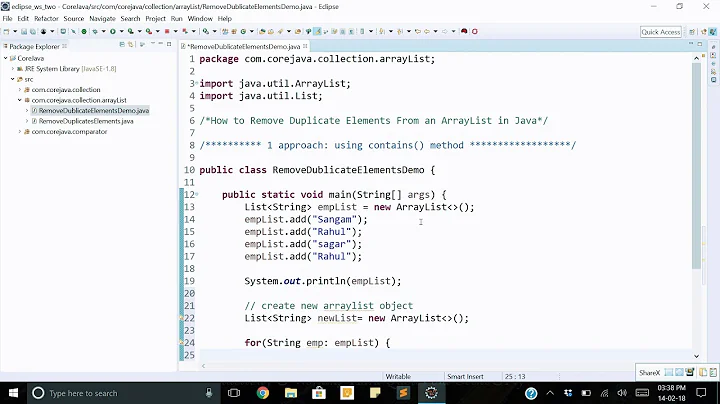Java: Detect duplicates in ArrayList?
Solution 1
Simplest: dump the whole collection into a Set (using the Set(Collection) constructor or Set.addAll), then see if the Set has the same size as the ArrayList.
List<Integer> list = ...;
Set<Integer> set = new HashSet<Integer>(list);
if(set.size() < list.size()){
/* There are duplicates */
}
Update: If I'm understanding your question correctly, you have a 2d array of Block, as in
Block table[][];
and you want to detect if any row of them has duplicates?
In that case, I could do the following, assuming that Block implements "equals" and "hashCode" correctly:
for (Block[] row : table) {
Set set = new HashSet<Block>();
for (Block cell : row) {
set.add(cell);
}
if (set.size() < 6) { //has duplicate
}
}
I'm not 100% sure of that for syntax, so it might be safer to write it as
for (int i = 0; i < 6; i++) {
Set set = new HashSet<Block>();
for (int j = 0; j < 6; j++)
set.add(table[i][j]);
...
Set.add returns a boolean false if the item being added is already in the set, so you could even short circuit and bale out on any add that returns false if all you want to know is whether there are any duplicates.
Solution 2
Improved code, using return value of Set#add instead of comparing the size of list and set.
public static <T> boolean hasDuplicate(Iterable<T> all) {
Set<T> set = new HashSet<T>();
// Set#add returns false if the set does not change, which
// indicates that a duplicate element has been added.
for (T each: all) if (!set.add(each)) return true;
return false;
}
Solution 3
With Java 8+ you can use Stream API:
boolean areAllDistinct(List<Block> blocksList) {
return blocksList.stream().map(Block::getNum).distinct().count() == blockList.size();
}
Solution 4
If you are looking to avoid having duplicates at all, then you should just cut out the middle process of detecting duplicates and use a Set.
Solution 5
Improved code to return the duplicate elements
- Can find duplicates in a Collection
- return the set of duplicates
- Unique Elements can be obtained from the Set
public static <T> List getDuplicate(Collection<T> list) {
final List<T> duplicatedObjects = new ArrayList<T>();
Set<T> set = new HashSet<T>() {
@Override
public boolean add(T e) {
if (contains(e)) {
duplicatedObjects.add(e);
}
return super.add(e);
}
};
for (T t : list) {
set.add(t);
}
return duplicatedObjects;
}
public static <T> boolean hasDuplicate(Collection<T> list) {
if (getDuplicate(list).isEmpty())
return false;
return true;
}
Related videos on Youtube
Admin
Updated on July 08, 2022Comments
-
 Admin almost 2 years
Admin almost 2 yearsHow could I go about detecting (returning true/false) whether an ArrayList contains more than one of the same element in Java?
Many thanks, Terry
Edit Forgot to mention that I am not looking to compare "Blocks" with each other but their integer values. Each "block" has an int and this is what makes them different. I find the int of a particular Block by calling a method named "getNum" (e.g. table1[0][2].getNum();
-
Paul Tomblin about 15 yearsIf "Block" is compared by an int, you should probably have hashCode return that same int and have equals compare those ints.
-
dmarquina almost 5 yearsuse Set instead of List
-
-
 jon077 about 15 yearsMake sure to implement hashCode/equals as well.
jon077 about 15 yearsMake sure to implement hashCode/equals as well. -
Fabian Steeg about 15 yearsOr even a bit easier: wrap it when creating the set, e.g. new HashSet(list), instead of using addAll.
-
palantus about 15 years@jon077: That depends on your definition of "duplicate".
-
 Admin about 15 yearsWould the process of detecting the elements in a 2D array be the same? For example, checking from array[0][0] to array[0][6] (a 'row')..? Many thanks, Terry
Admin about 15 yearsWould the process of detecting the elements in a 2D array be the same? For example, checking from array[0][0] to array[0][6] (a 'row')..? Many thanks, Terry -
 Admin about 15 yearsEach object in the array holds an integer value. By "duplicate", the object would have the same integer value.
Admin about 15 yearsEach object in the array holds an integer value. By "duplicate", the object would have the same integer value. -
Paul Tomblin about 15 yearsTerry, there are probably more efficient ways, but yes, you could add the array to a Set and compare Set.size to array.length.
-
Nikhil about 15 years"Duplicate" has multiple meanings for objects (as opposed to primitives). If you're just using ints, or the Integer class which implements equals(), that shouldn't be an issue.
-
 jon077 about 15 yearsMake sure to implement hashCode/equals :)
jon077 about 15 yearsMake sure to implement hashCode/equals :) -
palantus about 15 years@jon077: Not necessarily, as I just said.
-
 Admin about 15 yearsI'm trying to implement the solution above but it seems to be triggering an error message which says: "myFile.java uses unchecked or unsafe operations" Not quite sure what it meansor what to do!
Admin about 15 yearsI'm trying to implement the solution above but it seems to be triggering an error message which says: "myFile.java uses unchecked or unsafe operations" Not quite sure what it meansor what to do! -
Paul Brinkley about 15 yearsI think we'd have to see the code you actually wrote. The snippet in the answer isn't intended to compile as written, but what was written, should compile fine, provided you filled in the bits well.
-
Paul Tomblin about 15 yearsYou can't turn a table into a list like that. Look at the Arrays class.
-
Paul Tomblin about 15 yearsIf you're trying to turn the entire 36 Block objects into a single list, you need to loop.
-
Paul Tomblin about 15 yearsComments aren't a good place to solve a secondary problem like this. Edit your question and I'll edit the answer, or ask a new question.
-
 Admin about 15 yearsAh, I see that a "table" is a different thing entirely. Assume that "table1" is the name given to 2D array of "Block" objects
Admin about 15 yearsAh, I see that a "table" is a different thing entirely. Assume that "table1" is the name given to 2D array of "Block" objects -
 Admin about 15 yearsSorry about the clutter in the comments, I've now edited my question. Thank you for the help so far!
Admin about 15 yearsSorry about the clutter in the comments, I've now edited my question. Thank you for the help so far! -
 Admin about 15 yearsOk, so from what I can tell, the loops add each 'row' to a Set. So am i correct in thinking that now all that remains to do is compare each Set to the size of table1 (and if Set's size is less than the size of table1's size then there are duplicates)?
Admin about 15 yearsOk, so from what I can tell, the loops add each 'row' to a Set. So am i correct in thinking that now all that remains to do is compare each Set to the size of table1 (and if Set's size is less than the size of table1's size then there are duplicates)? -
Paul Tomblin about 15 yearsYou said you wanted to find out if there were any duplicates within a row, not over the whole table. That's why I compare the set.size() to 6.
-
 Admin about 15 yearsUpdate: Solution implemented and working! Thank you all for your input on this problem and special thanks to Paul for going out of your way to help! Warm Regards, Terry
Admin about 15 yearsUpdate: Solution implemented and working! Thank you all for your input on this problem and special thanks to Paul for going out of your way to help! Warm Regards, Terry -
Paul Tomblin about 15 yearsIn this case, n is 6 so I wouldn't waste a lot of time on implementation details, but I'll keep your idea of the special heap sort if I ever need to do something like that.
-
ChaimKut almost 12 yearsI don't understand the third paragraph. Mergesort and heapsort are both O(nlog(n)), not O(log(n)) as you write; even if you exit once you identify a duplicate, that still doesn't change your time complexity...
-
Jules Colle over 11 yearsThat's pretty awesome. you have some invalid code, and maybe it's not the most optimal way, but your approach totally rocks! (and it works great)
-
Paul Jackson about 10 yearsWould it be more efficient to tell the HashSet how much space to allocate:
Set<T> set = new HashSet<T>(list.size());? Given a List parameter I think it is more efficient if it is common for the list to not contain duplicates. -
 NIMISHAN over 8 yearshow can i do it to a array list with a given sliding window , example 100 indexes with sliding window size 5? ABCAD should output : ABCAD = 00010 and if the next value is E, then BCADE should output : 00000
NIMISHAN over 8 yearshow can i do it to a array list with a given sliding window , example 100 indexes with sliding window size 5? ABCAD should output : ABCAD = 00010 and if the next value is E, then BCADE should output : 00000 -
Paul Tomblin over 8 years@NIMISHAN ask your own question, don't try to hijack this one.
-
 ρяσѕρєя K almost 7 yearsAdd some explanation with answer for how this answer help OP in fixing current issue
ρяσѕρєя K almost 7 yearsAdd some explanation with answer for how this answer help OP in fixing current issue -
 mcallahan over 6 yearsHowever using a Set does not detect duplicates. It just prevents them. Unless of course you check the result of the add method as noted by @akuhn above.
mcallahan over 6 yearsHowever using a Set does not detect duplicates. It just prevents them. Unless of course you check the result of the add method as noted by @akuhn above. -
Jay Anderson about 6 years@PaulJackson Sizing based on the full list will probably be beneficial. However if the common case is for it to find a duplicate early then the space was wasted. Also even sizing the
HashSetto the size of the list will result in resizing when running through the whole list because of the underlying loading factor of the hash structure. -
 Sandeep Chauhan about 6 yearsUnless you experience actual issues with runtime or space I would not finetune your code like that. Premature optimization is best avoided.
Sandeep Chauhan about 6 yearsUnless you experience actual issues with runtime or space I would not finetune your code like that. Premature optimization is best avoided. -
Christophe Roussy about 5 yearsSimplest and best answer if you want the duplicates, for performance you may init uniqueSet hint with size of args.
-
Sergiy Dakhniy over 3 yearsThat's too expensive considering algorithmic complexity. Best sorting is O(n*log(n)) while you can find duplicates with O(n) complexity.
-
Jezor over 3 yearsCould be even shorter:
return stream.allMatch(new HashSet<>()::add); -
 Petr Dvořák almost 3 yearsCommenting just to remove confusing info from the internet. The time complexity of the accepted answer is actually O(n) when using insertion to HashSet. The memory complexity is doubled, but still O(n)... you do not need to sort anything unless you have a requirement of minimalistic memory impact...
Petr Dvořák almost 3 yearsCommenting just to remove confusing info from the internet. The time complexity of the accepted answer is actually O(n) when using insertion to HashSet. The memory complexity is doubled, but still O(n)... you do not need to sort anything unless you have a requirement of minimalistic memory impact...






